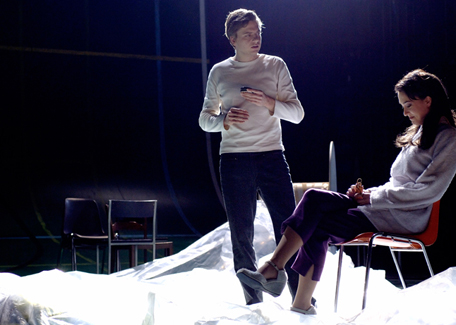DIRECTOR
> THEATRE | MUSICAL THEATRE | OPERA | SPECIAL PROJECTS
Romeo & Julia
(2006)
Isolated by a natural disaster a group of people locked themselves into a basketball court hoping that the horror is mitigated. They kill time: telling stories: one of the stories thy share - in the manner of a modern Decameron - is Romeo & Juliet’s - everyone knows it. They are enthusiastic with the idea. They retell it, they re-enact it: they live it, they turn it biography.
(…)
The story casts in reality. The lovers’ suicide awakens the dark will to carry out this act in a massive way: the danger threatens from outside the basketball court: the solution seems to be voluntary death. The whole group - as the history of R&J unfolds - is dictating its suicide will. In this way R&J becomes the material reality of this bunch of people. The presentation space (the field) becomes the space of representation (Verona or Mantua) and vice versa. The fiction constructs reality or reality constructs fiction or even better: no border between them: only the will to name this or that in a reassuring way in order to save oneself from the boundaries of imprecise.
Alejandro Tantanian
-
Romeo & Julia (Romeo & Juliet)
Version by Alejandro Tantanian from William Shakespeare’s Romeo & Juliet -
with
Julia
Anna Eger -
Romeo
Philippe Graber -
Lord Capulet and Lord Montague
Christoph Künzler -
Friar Laurence
Henry Meyer -
Tybalt
Jürgen Sarkiss -
Nurse
Anja Schweitzer -
Lady Capulet and Lady Montague
Anna Stieblich -
Mercutio
Peter Waros - Paris
Christoph Gerega -
Romeo's friend
Martina Potratz -
Romeo's friend
Roland Bonjour -
Friar Markus
Kai Wissner -
and the children
Kenneth Häcki, Matina Suppich, Pascal Schärli & Mara Schmeid. -
Lights
Gerard Cleven -
Set
Jorge Macchi & Oscar Carballo -
Costumes
Oria Puppo -
Music and sound design
Edgardo Rudnitzky -
Dramaturgy
Caroline Weber -
Direction
Alejandro Tantanian -
Running time: 150 minutes with an interval.
-
Premiere: January 13th, 2006, Luzerner Theater, Luzern, Switzerland
-
